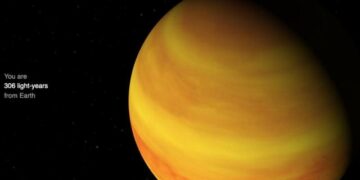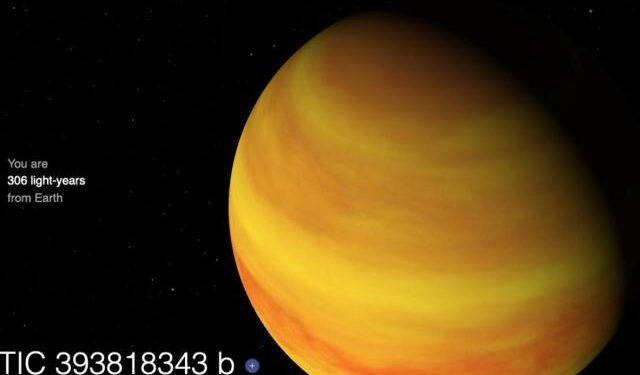A New Discovery in Exoplanet Hunting: The Rise of Citizen Science
Amateur astronomers just made a huge find: TIC 393818343 b, a “warm Jupiter.” Thanks to NASA’s UNITE and Exoplanet Watch, backyard stargazers are proving that big discoveries aren’t just for the pros. This planet’s discovery is a game-changer, shedding light on how giant planets form and move.
The Collaborative Effort Behind TIC 393818343 b’s Discovery
The discovery of TIC 393818343 b is a shining example of how collaboration between professional and amateur astronomers can yield impressive results. Initially identified by NASA’s Transiting Exoplanet Survey Satellite (TESS), this new planet’s journey to confirmation was far from straightforward. TESS uses the transit method, observing stars for slight dimming caused when a planet passes in front of them. However, seeing a single dimming event isn’t enough to confirm a planet’s existence. That’s where amateur astronomers stepped in, armed with telescopes and enthusiasm.
Following the initial detection, the UNISTELLAR Network and Exoplanet Watch rallied volunteers to observe the predicted next transit of TIC 393818343 b. Through coordinated observations, these citizen scientists confirmed two additional transits, proving the object detected by TESS was indeed a planet. This successful collaboration highlights how citizen science is expanding the boundaries of astronomical research, allowing more exoplanet candidates to be confirmed efficiently.
Understanding Warm Jupiters: A Unique Class of Exoplanets
TIC 393818343 b belongs to a unique class of exoplanets known as warm Jupiters, which are gas giants similar in size to Jupiter but orbit much closer to their host stars. Unlike the distant orbit of our Jupiter, this newly discovered exoplanet orbits its star at only 12% of the distance between Earth and the Sun, resulting in a year that lasts just 16 days. This proximity places TIC 393818343 b in an intermediary position between regular Jupiters and the infamous hot Jupiters, which orbit so close to their stars that their atmospheres are bloated by extreme heat.
Warm Jupiters like TIC 393818343 b are crucial for understanding the migratory behavior of gas giants. These planets are thought to be in a transitional phase, moving inward toward their stars. Studying TIC 393818343 b provides astronomers with a real-time glimpse into this process, offering insights into how gas giants can shift from distant orbits to dangerously close ones. This discovery allows researchers to piece together the stages of planetary evolution, contributing to broader theories about planetary system formation and migration.
Why This Discovery Matters: Insights into Planetary Migration
The discovery of TIC 393818343 b offers more than just another exoplanet to study; it provides a valuable window into the forces that shape planetary systems. Planetary migration, the process by which planets move from their original orbits, is a key area of study in exoplanet research. TIC 393818343 b’s highly eccentric orbit—significantly more stretched out compared to planets like Jupiter—suggests that gravitational interactions or remnants of the protoplanetary disk may be nudging these planets inward. Understanding these dynamics helps explain why we observe so many hot Jupiters in the galaxy despite their apparent instability.
For astronomers, observing a warm Jupiter in its migratory phase is akin to finding a missing puzzle piece. By studying TIC 393818343 b, scientists can better understand the timeline and mechanisms behind planetary migration. This has broader implications for understanding our own solar system’s history, shedding light on how Jupiter and other gas giants may have influenced the layout and stability of planets within our cosmic neighborhood.
The Power of Citizen Science: Democratizing Astronomy
One of the most remarkable aspects of TIC 393818343 b’s discovery is the role of citizen science in making it happen. Projects like UNITE and Exoplanet Watch enable everyday individuals—from students to retirees—to contribute to cutting-edge research. This democratization of astronomy opens the door for anyone with a telescope and an interest in the stars to participate in meaningful scientific work. Volunteers across the globe, from Australia to the United States, played a crucial role in confirming this exoplanet, demonstrating the growing importance of citizen science in the field of astronomy.
Citizen science not only accelerates the pace of discovery but also allows professional astronomers to focus their resources on the most promising targets. By delegating observations to volunteers, initiatives like UNITE and Exoplanet Watch vastly increase the capacity for data collection and analysis, ensuring that exoplanet candidates identified by TESS and other surveys receive the attention they need for confirmation. This collaborative approach has proven highly effective, as seen in the successful confirmation of TIC 393818343 b.
Looking Ahead: The Future of Exoplanet Research
The discovery of TIC 393818343 b is just the beginning. As technology continues to advance and more people become involved in citizen science, the potential for new discoveries grows exponentially. Warm Jupiters like TIC 393818343 b provide invaluable opportunities to study the dynamics of planetary migration, offering clues about the broader processes that govern planetary systems. With thousands of exoplanet candidates still awaiting confirmation, there’s no shortage of work to be done, and the involvement of citizen scientists will be crucial in meeting this challenge.
This discovery also underscores the importance of continued investment in citizen science initiatives. By supporting projects that engage the public, we not only expand our scientific capabilities but also inspire the next generation of astronomers. The story of TIC 393818343 b is a testament to what can be achieved when people come together to explore the cosmos, turning a hobby into a significant contribution to our understanding of the universe.
Conclusion: A New Era of Discovery
The confirmation of TIC 393818343 b isn’t just a triumph of scientific observation; it’s a triumph of collaboration, passion, and the power of citizen science. This discovery shows that with the right tools, anyone can be a part of groundbreaking research, contributing to humanity’s quest to understand the universe. As we continue to explore the stars, the involvement of amateur astronomers will undoubtedly play a pivotal role in future discoveries, proving that the spirit of curiosity is alive and well, lighting the way to the next great cosmic find.
Reference:
“Confirmation and Characterization of the Eccentric, Warm Jupiter TIC 393818343 b with a Network of Citizen Scientists” by Lauren A. Sgro, Paul A. Dalba, Thomas M. Esposito, et al., published in The Astronomical Journal on June 24, 2024.
A Single-transit Planet Candidate Detected from TESS G. Conzo and M. Moriconi : https://iopscience.iop.org/article/10.3847/2515-5172/ad2c85



















